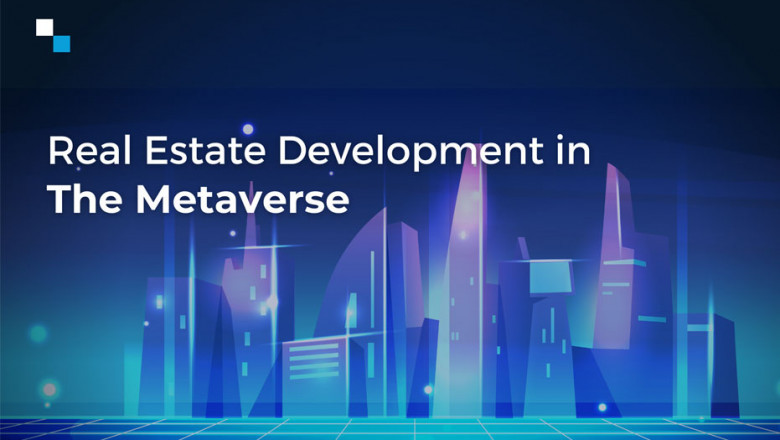views

Just like any physical world, a metaverse constitutes real-estate assets. To create a functional environment of social and economic relevance, it is important to work at the ground level and build qualitative real-estate properties. In the following guide, we discuss everything you wanted to know about metaverse real estate development.
The era of web 3.0 is committed to delivering a user-owned and immersive experience, and metaverse is just the right fit to actualize the mission. Think of it as a new city coming up with different types of new real-estate properties.
For example, a home, institution, community halls, marketplaces, e-stores, game battlegrounds etc. are just a few names.
Moreover, it is an opportunity to encompass multiple use cases of decentralization on a single platform.
In these times when remote operations are of paramount importance, metaverse real-estate development is a crucial step in the direction.
What is Metaverse Real-Estate?
Real estate in the metaverse represents pieces of land, buildings, or infrastructure that occupies a space.
To put it simply, the digitized version of real-estate properties from the physical world inside the virtual world, with an interaction layer is the metaverse real estate.
Metaverse real estate enables consumers to buy land in the metaverse. These parcels of land work like pixels but are much more than digital images.
Real estate spaces in the Metaverse are programmable so that users can play games, socialize at ease, sell their NFTs, and attend meetings & virtual concerts along with countless other activities in real-time.
Furthermore, the increasing popularity of VR is pushing the actualization of metaverse projects. Unlike earlier when people had to visit the physical site, the metaverse is accessible from the comfort of a room.
The immersive technology now allows potential customers to buy and sell their properties irrespective of their location in a 3D world.
Users can also create their personal 3D experiences be it browsing through a virtual shop or playing a game in real-time. They can also buy real estate in Metaverse with NFTs.
The User Journey inside a Metaverse
So, let us visualize the journey of a user who is looking to buy land in the metaverse.
Step 1
Users visit multiple real-estate properties or sites within multiple metaverses such as Axie Infinity, Decentraland, Sandbox etc.
Same as they would visit multiple property sites in different locations or even regions. They compare multiple pieces of land, their price, and other factors. Moreover, the features and other details are available with a click.
The user can also ask for virtual tours.
Step 2
Next, the user would link their metaverse compliant digital wallet with the platform. Wallets such as Metamask, AnCrypto, Binance etc. are compatible with most leading blockchain metaverse platforms.
They should fund their wallet with the native cryptocurrency of the metaverse. For example, they should procure MANA if they are building the metaverse inside the Decentraland.
Step 3
Once you complete the transaction, the piece of digital land purchased by you is stored in the form of NFTs in your linked digital wallet. You can view your acquired land under the ‘NFTs’ tab in your digital wallet.
Opportunities in the Metaverse Real Estate
Like conventional real estate, properties can be developed, bought, and sold easily in the Metaverse. Property owners can easily rent out their virtual land or space to others.
Transacting on the Metaverse for real estate is much more hassle-free when compared to traditional real estate as users can find suitable properties, do the paperwork, and deal with agents, brokers and transactions from the comfort of their homes.
Likewise, users can also buy metaverse land and further rent it out.
These features make the real estate in the Metaverse much more flexible. Users buy a piece of land and develop any property of their choices like a school, shop, gallery, or event centre with ease.
This space holds explosive potential for real estate companies to build ROIs.
Metaverse Real Estate Property Management
Property management is an exciting opportunity for virtual real estate metaverse businesses. Just as real estate is important for all businesses in the physical world, the virtual world too has its potential.
Regardless of the business/asset type, there is a huge scope of metaverse real-estate development. Apart from letting users buy land in the metaverse, other key services include:
-
- Property rental management for clients
- Tech & visual property management
- Rental collection
- Point of contact for all client-related issues and inquiries
Metaverse Real-Estate Property Development
You can offer full-stack property development services in the metaverse. In collaboration with a metaverse real-estate development company, you can unlock a profitable business model.
The blockchain company can help you in real estate development and you can use the freed-up time for other critical areas.
-
- Architecting your build
- Designing your build
- Developing your build
- Establishing development on the map
NFT Real Estate Metaverse
NFT real estate metaverse is a fast-growing industry attracting enterprises and consumers alike. Tokenizing real-estate assets into non-fungible tokens lets owners earn passive income.
Enterprises can offer to tokenize a room, a piece of land, a building, or a whole city into NFTs or a collection of NFTs.
NFTs represent different assets in the form of objects, avatars, skills and other assets nowadays.
Steps to Build Real Estate in the Metaverse
At the component level, metaverse real-estate development includes building the infrastructure, creating content and ultimately defining the operational logic through protocols.
At this stage, you are building the framework of the property. The digital infrastructure should enable multiple utilities for the users in the metaverse.
Next is filling the properties with content such as design, layouts, assets, and the scope of activities.
Lastly, define the operational protocols and standards. These would define the governing rules and the policies, business logic such as buy/sell rental agreements etc.
Step 1: Choose a Metaverse Platform
Now, building a real-estate space inside a metaverse requires a diverse range of skills. First things first, choose the underlying blockchain platform.
So far, all major blockchain platforms such as Ethereum, Polygon, Algorand, Solana and others offer the infrastructure to create a democratic and community-driven virtual world.
That means a metaverse over the blockchain is backed by the functionality of a smart contract that triggers certain actions based on predetermined conditions.
For optimal functionality, we need decentralized finance and that’s why enabling cryptocurrencies and NFTs is important.
You can either choose existing blockchain metaverse platforms such as Decentraland, Sandbox etc. to create real-estate properties inside them.
If you want to build a bigger and more customized platform, then building a metaverse ecosystem from scratch and then further building real-estate properties is the key.
Since the existing metaverse platforms are still in their nascent stage, it is a wise choice to build a metaverse from scratch and embed functionalities and features as per your choice.
Here, a professional metaverse development company can optimize the process for you.
Step 2: Write Metaverse Smart Contract
A metaverse smart contract is an immutable ‘rules’ document that triggers certain actions upon meeting a set of conditions. For example, triggering a transaction between a buyer and seller once both sides click on ‘Agree’ is a functionality of the smart contract.
In another example, smart contracts define and execute rental agreements between two parties.
This includes discontinuing the contract if the tenant breaches certain policies or codes of conduct.
To fully avail the benefits of a virtual real estate metaverse environment, smart contracts are the core. You can also include an NFT smart contract to tokenize real-estate assets into non-fungible entities.
Based on the blockchain platform, you will need to work on smart contracting. Exactly at this point, you would need the expertise of a metaverse blockchain development company.
Since real estate, be it in the physical or the virtual realm depends upon finance for growth, blockchain is an integral component of your project.
Step 3: Design the Metaspace
Once you have chosen the platform for metaverse digital real estate, the next step is obvious to design the metaspace.
A metaspace can be an app, a virtual meeting room, a virtual conference hall, or even a virtual home theatre.
Metaspace is a virtual space that a user can access via a VR headset.
Once you have finalized the platform, the next step is to ideate the metaverse real-estate property. It means creating the architecture of the property.
The scope of designing a metaspace can range from a room, building, stadium, or even a full-fledged city. It requires a similar level of architectural designing expertise as for real estate properties in the physical world.
With the backing of a metaverse development company, you can easily execute 3D designing and virtual reality application development in line with the objective of a blockchain-enabled platform.
Step 4: Build an Interaction Layer
Next, is building the interaction layer. At this stage, you are building the application logic to enable characters and assets to interact with the metaverse digital real estate.
This layer determines the accessibility, navigation, communication protocols, and user controls. A simple example is a user accessing the main gate of a real estate property such as an event hall through an admission pass.
At this layer, require to define the integration with external applications. For example, video calling applications like Zoom, smart glasses, virtual reality goggles, headsets, haptic gloves, sensors etc., are required.
Everything builds the interaction between the physical realm with the metaverse enabled at this layer.
Step 5: Build an interoperability layer
Interoperability extends the scope of the metaverse and attracts wider participation. For example, a user of one metaverse may want to pay for and attend an event happening inside a real estate property in the other.
To achieve the same, interoperability between different underlying blockchain systems is important.
To build a fully functional virtual world, it is important to drive cross-environment transactions. Thus, choose a blockchain that drives secure and fast transactions through payment gateways.
Skills-stack Required for Metaverse Real Estate Development
The era of web 3.0 produces a very different internet from what we had known over the years. Also known as the 3D iteration of the web 2.0, it is all about protocols for immersive experience, ownership, and engagements as liberal as possible.
To be able to build a real-estate infrastructure in the metaverse, it will require a more complicated, and resilient set of interoperability to deliver such experiences.
Following are some of the key standards and other key requirements integral for the development of a real-estate platform development inside a metaverse.
-
- A layer-1 or 2 blockchains that would enable the underlying infrastructure of a decentralized network of computer systems (nodes).
- Enable smart contract functionality for implementing business logic and conduct transparent, secure and permissionless transactions.
- Open standard for multi-media like images, audio/video files, text, 3D sequences, scenes and other supported vectors.
- Programming languages such as HTML, WebXR, WebAssembly, WebGPU, Solidity, Python, and others.
- Extended Reality (XR) for building connections between real and virtual environments.
Examples are smart glasses, Haptic gloves, VR headsets, sensors, gaming consoles and others. - 3D simulation to re-create real-world immersive environments.
- Payment gateways to support digital currencies.
How to Find the Best Metaverse Real-Estate Development Company
Since you are familiar with the digital real estate metaverse development, it’s time to find a tech partner.
While finding a metaverse development company, check for the following qualifications.
Prior experience in blockchain development is a must. Even though metaverse is relatively newer, your tech partner should have sufficient experience in building blockchain applications of different types.
An ideal company should have experience in working on Ethereum, Polygon, Solana, Algorand and others.
Next, they should have proven experience in working on NFT real estate metaverse projects. Among all NFTs are the most popular metaverse use case. They allow financial enablement of digital assets including real estate properties.
So while building your real-estate property inside a metaverse, NFTs will be crucial in garnering more users. Your tech partner should have sufficient experience in the NFT tokenization of a wide variety of assets.
The tech partner should have end-to-end experience in building gaming environments. Now, even though the scope of real estate doesn’t necessarily need gaming experience, it showcases a team’s proficiency in building virtual worlds on a storyline.
Apart from these, understanding web 3.0, its impact and the ability to address real-life issues through virtual reality are a few other metrics to finalize upon your tech partner.
Build Metaverse Real Estate with Antier Solutions
In this article, we discussed the meaning, scope, development process of real-estate in the metaverse. Despite its nascent stage, metaverse real-estate assets are fast becoming popular.
As a full stack metaverse development company, Antier utilizes its blockchain potential to build high performing virtual environments.
While we hope you had a pleasant read, we’d recommend reaching out to us to discuss the potential in detail.
Do you have a real estate project in mind? We have a metaverse solution for you.












